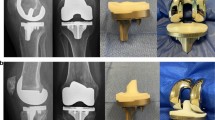Abstract
Purpose
Modified postural stability after retaining the posterior cruciate ligament (PCL) in total knee arthroplasty is still discussed controversially. The objective of this study was to evaluate whether a PCL-retaining implant design should be preferred over a PCL-substituting implant design regarding postural stability in one-leg stance and clinical outcome.
Methods
Forty patients underwent total knee arthroplasty, 20 of them with a cruciate-retaining (CR) and 20 of them with a cruciate-substituting (PS) implant system. Postural stability was analysed 6 months postoperatively in one-leg stance using the Biodex Balance System. In addition, the Western Ontario and McMaster Universities Arthritis Index (WOMAC) and Knee Society Score were completed.
Results
This study shows that there is no significant difference in postural stability between CR and PS) implant systems with PS implants showing better results in WOMAC score.
Conclusions
In case it is necessary to use a PS implant, no negative influence on postural stability is to be expected compared to a CR implant.


Similar content being viewed by others
References
Centers for Disease Control and Prevention (2015) FastStats – inpatient surgery http://www.cdc.gov/nchs/fastats/inpatient-surgery.htm. Accessed 8 Aug 2015
Verra WC, van den Boom LG, Jacobs W, Clement DJ, Wymenga AA, Nelissen RG (2013) Retention versus sacrifice of the posterior cruciate ligament in total knee arthroplasty for treating osteoarthritis. Cochrane Database Syst Rev 10:CD004803. doi:10.1002/14651858.CD004803.pub3
Hunt NC, Ghosh KM, Blain AP, Rushton SP, Longstaff LM, Deehan DJ (2015) No statistically significant kinematic difference found between a cruciate-retaining and posterior-stabilised Triathlon knee arthroplasty: a laboratory study involving eight cadavers examining soft-tissue laxity. Bone Joint J 97-B(5):642–648. doi:10.1302/0301-620X.97B5.34999
Freeman MA, Pinskerova V (2005) The movement of the normal tibio-femoral joint. J Biomech 38(2):197–208
Kapandji I (2006) Funktionelle Anatomie der Gelenke, vol 2, 4th edn. Thieme, Stuttgart, p 84
Bachmann M, Bolliger L, Ilchmann T, Clauss M (2014) Long-term survival and radiological results of the Duracon™ total knee arthroplasty. Int Orthop 38(4):747–752. doi:10.1007/s00264-013-2154-4
Yue B, Varadarajan KM, Rubash HE, Li G (2012) In vivo function of posterior cruciate ligament before and after posterior cruciate ligament-retaining total knee arthroplasty. Int Orthop 36(7):1387–1392. doi:10.1007/s00264-011-1481-6
Dennis DA, Komistek RD, Mahfouz MR, Haas BD, Stiehl JB (2003) Multicenter determination of in vivo kinematics after total knee arthroplasty. Clin Orthop Relat Res 416:37–57
Dennis DA, Komistek RD, Colwell CE Jr, Ranawat CS, Scott RD, Thornhill TS, Lapp MA (1998) In vivo anteroposterior femorotibial translation of total knee arthroplasty: a multicenter analysis. Clin Orthop Relat Res 356:47–57
Baier C, Fitz W, Craiovan B, Keshmiri A, Winkler S, Springorum R, Grifka J, Beckmann J (2014) Improved kinematics of total knee replacement following partially navigated modified gap-balancing technique. Int Orthop 38(2):243–249. doi:10.1007/s00264-013-2140-x
Zhang K, Mihalko WM (2012) Posterior cruciate mechanoreceptors in osteoarthritic and cruciate-retaining TKA retrievals: a pilot study. Clin Orthop Relat Res 470(7):1855–1859. doi:10.1007/s11999-011-2120-7
Vandekerckhove PJ, Parys R, Tampere T, Linden P, Van den Daelen L, Verdonk PC (2015) Does cruciate retention primary total knee arthroplasty affect proprioception, strength and clinical outcome? Knee Surg Sports Traumatol Arthrosc 23(6):1644–1652. doi:10.1007/s00167-014-3384-8
Swanik CB, Lephart SM, Rubash HE (2004) Proprioception, kinesthesia, and balance after total knee arthroplasty with cruciate-retaining and posterior stabilized prostheses. J Bone Joint Surg Am 86-A(2):328–334
Insall JN, Dorr LD, Scott RD, Scott WN (1989) Rationale of the Knee Society clinical rating system. Clin Orthop 248:13–14
Lingard EA, Katz JN, Wright RJ, Wright EA, Sledge CB, Kinemax Outcomes Group (2001) Validity and responsiveness of the Knee Society Clinical Rating System in comparison with the SF-36 and WOMAC. J Bone Joint Surg Am 83-A(12):1856–1864
Bellamy N, Buchanan WW, Goldsmith CH, Campbell J, Stitt LW (1988) Validation study of WOMAC: a health status instrument for measuring clinically important patient relevant outcomes to antirheumatic drug therapy in patients with osteoarthritis of the hip or knee. J Rheumatol 15:1833–1840
Woollacott MH, Tang PF (1997) Balance control during walking in the older adult: research and its implications. Phys Ther 77:646–660
Arnold BL, Schmitz RJ (1998) Examination of balance measures produced by the biodex stability system. J Athl Train 33(4):323–327
Finn JA, Alvarez MM, Jett RE, Axtell DS, Kemler DD (1999) Stability performance assessment among subjects of disparate balancing abilities. Med Sci Sports Exerc 31:S2529
Sando T, McCalden RW, Bourne RB, MacDonald SJ, Somerville LE (2015) Ten-year results comparing posterior cruciate-retaining versus posterior cruciate-substituting total knee arthroplasty. J Arthroplasty 30(2):210–215. doi:10.1016/j.arth.2014.09.009
Seon JK, Yim JH, Seo HY, Song EK (2013) No better flexion or function of high-flexion designs in Asian patients with TKA. Clin Orthop Relat Res 471(5):1498–1503. doi:10.1007/s11999-012-2629-4
Luo SX, Zhao JM, Su W, Li XF, Dong GF (2012) Posterior cruciate substituting versus posterior cruciate retaining total knee arthroplasty prostheses: a meta-analysis. Knee 19(4):246–252. doi:10.1016/j.knee.2011.12.005
Barrett DS, Cobb AG, Bentley G (1991) Joint proprioception in normal, osteoarthritic and replaced knees. J Bone Joint Surg Br 73:53–56
Warren PJ, Olanlokun TK, Cobb AG, Bentley G (1993) Proprioception after knee arthroplasty. The influence of prosthetic design. Clin Orthop 297:182–187
Author information
Authors and Affiliations
Corresponding author
Ethics declarations
Conflicts of interest
No conflict of interest exists. The other authors have no external sources of support. No company has had any role in the study design; the data collection, analysis, and interpretation; the manuscript preparation; or the manuscript submission.
Rights and permissions
About this article
Cite this article
Götz, J., Beckmann, J., Sperrer, I. et al. Retrospective comparative study shows no significant difference in postural stability between cruciate-retaining (CR) and cruciate-substituting (PS) total knee implant systems. International Orthopaedics (SICOT) 40, 1441–1446 (2016). https://doi.org/10.1007/s00264-015-3067-1
Received:
Accepted:
Published:
Issue Date:
DOI: https://doi.org/10.1007/s00264-015-3067-1




